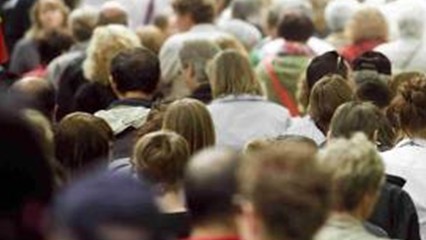发布时间: 2017年01月05日

『在模拟人群行为时,不应当把他们看作液体中的分子,而要把他们看作人,这样才更接近真实情况。』
Wisdom about crowds
当人成群时
Apr 20th 2011 | from The Economist

The behaviour of crowds is sometimes unpredictable and occasionally deadly, but there is good reason to believe it is governed by simple rules. Presumably, like molecules in a liquid, people in a crowd all behave in more or less the same way. Capture those similarities in a model and it should be possible to predict how a crowd will behave.
Existing models of crowd behaviour do just that. They treat moving masses of humanity as though they were fluids. This works, up to a point. But it often fails to predict the changes that happen as a crowd’s density increases and its movement becomes chaotic. That is why Mehdi Moussaid of Paul Sabatier University, in Toulouse, and his colleagues have made a radical innovation. Instead of treating the individual human beings in a crowd as if they were molecules, they have treated them as if they were human beings. They have, in other words, given them volition. Of course, the objective of someone in a moving crowd is usually fairly simple—to get somewhere and then stay there. But it is an objective, nevertheless.
As they describe in the Proceedings of the National Academy of Sciences, Dr Moussaid and his team built a computer model in which, initially, every virtual person in the crowd followed two rules. The first was that each attempted to chart as straight as possible a path to his destination, such as an exit or the end of a corridor, while avoiding obstacles, including other pedestrians. Second, each adjusted his speed, depending on his distance from such obstacles.
These two rules were enough to reproduce in the model the sorts of behaviour seen in real crowds, such as the tendency people have to sort themselves spontaneously into separate lanes of traffic moving in opposite directions and the stop-and-go motion that occurs as crowds become more dense. When Dr Moussaid really put the pressure on, however, by increasing the density of the virtual crowd, the model did not show the extreme turbulence seen in real crowds—the sudden crushes and chaotic changes in direction.
These happen because in extremely dense crowds there is so much shoving and jostling that people’s movements are no longer entirely under their own control. In other words, they actually do start behaving like molecules in a fluid, bouncing off one another at random. To mimic that behaviour, Dr Moussaid added a third rule, which made members of his crowd more molecule-like when they were at very close quarters—a lack of volition that will be familiar to anyone who has been in a tight jam of humanity.
With this third rule added, the model accurately reproduced the dynamics of dense crowds as well as those of sparser ones. At first, a crowd flows smoothly. Then, as more people are added, it begins to show stop-and-go patterns and sometimes extreme crushing. Finally, it displays the sort of turbulence that can lead to disaster. On one run, for example, the model showed precisely the pattern seen in a video of a catastrophe in Mecca in 2006, when 346 pilgrims there on the haj were crushed to death.
The practical upshot of all this, Dr Moussaid hopes, will be improvements in the design of public spaces where crowds are likely to gather, especially in the location of evacuation routes. That is an outcome greatly to be desired. And it was made possible by remembering that people are not molecules.
热门推荐:
上一篇: 考研阅读精选:曼哈顿—美国花园城市的典范
下一篇: 热原的概念|性质介绍